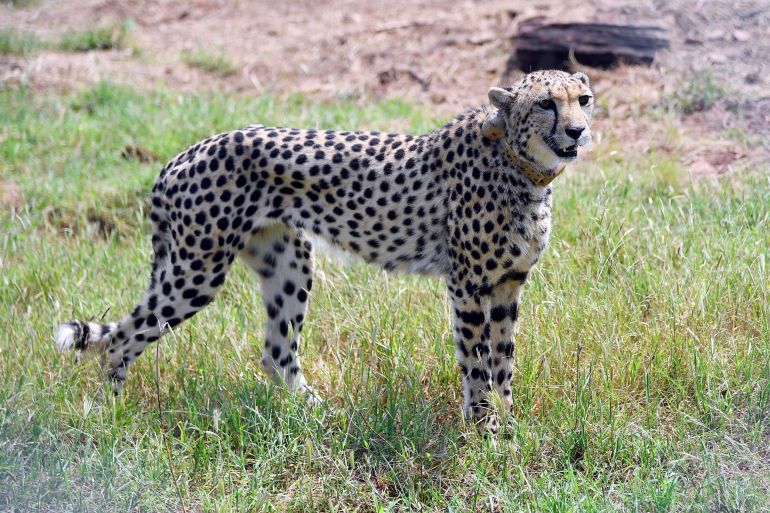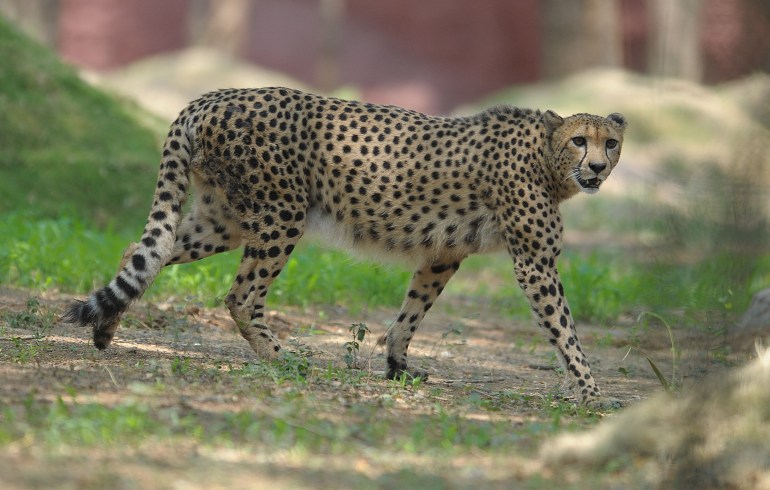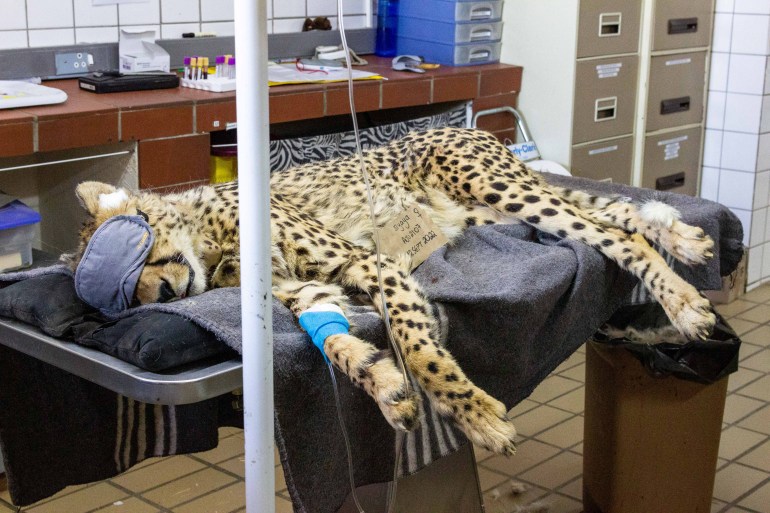India welcomes back cheetahs, 70 years after local extinction
Arrival of eight big cats from Namibia coincides with the 72nd birthday of Indian Prime Minister Modi who released the first into a wildlife park.

Eight Namibian cheetahs have arrived in India in an ambitious project to reintroduce the spotted creatures that has divided wildlife experts after the big cats’ local extinction decades ago.
Officials say the project is the world’s first intercontinental relocation of cheetahs, the planet’s fastest land animal. The five females and three males were moved from a game park in Namibia on board a chartered Boeing 747 dubbed “Cat Plane” for an 11-hour flight.
Keep reading
list of 4 itemsBodies of teenage Dalit sisters found hanging from tree in India
India’s Celebrity Hunters
Arrested Muslim boy, 8, gets bail a week after India violence
Prime Minister Narendra Modi presided over the release on Saturday at Kuno National Park, a wildlife sanctuary 320km (200 miles) south of New Delhi selected for its abundant prey and grasslands.
“Today the cheetah has returned to the soil of India,” Modi said in a video address after their arrival, which coincided with the leader’s 72nd birthday.
“The nature-loving consciousness of India has also awakened with full force. We must not allow our efforts to fail.”
Each of the animals, aged between two and five and a half, was fitted with a satellite collar to monitor their movements. They will initially be kept in a quarantine enclosure for about a month before being released in the open forest areas of the park.
Grow the population
Critics have warned the creatures may struggle to adapt to the Indian habitat. A significant number of leopards are present in the park, and conservation scientist Ravi Chellam said cubs could fall prey to feral dogs and other carnivores.
Under the government’s current action plan, “the prospects for a viable, wild and free-ranging population of cheetahs getting established in India is bleak”, he said.
“The habitats should have been prepared first before bringing the cats from Namibia. It is like us moving to a new city with only a sub-optimal place to stay. Not a nice situation at all.”
But organisers were unfazed.
“Cheetahs are very adaptable and [I’m] assuming that they will adapt well into this environment,” said Laurie Marker, founder of the Namibia-based charity Cheetah Conservation Fund (CCF), which has been central to the project logistics. “I don’t have a lot of worries.”
Another 12 cheetahs are expected to join the fledgling Indian population next month from South Africa.
As India gathers more funding for the 910 million rupee ($11.4m) project, largely financed by the state-owned Indian Oil, it hopes to eventually grow the population to about 40 cats.
Habitat loss and hunting
India was once home to the Asiatic cheetah but it was declared extinct in the country by 1952.
The critically endangered subspecies, which once roamed across the Middle East, Central Asia and India, are now only found, in very small numbers, in Iran.
Efforts to reintroduce the animals to India gathered pace in 2020 when the Supreme Court ruled that African cheetahs, a different subspecies, could be settled in India at a “carefully chosen location” on an experimental basis.
They are a donation from the government of Namibia, one of a tiny handful of countries in Africa where the magnificent creature survives in the wild.
Cheetahs became extinct in India primarily because of habitat loss and hunting for their distinctive spotted coats.
An Indian prince, the Maharaja Ramanuj Pratap Singh Deo, is widely believed to have killed the last three recorded cheetahs in India in the late 1940s.
One of the oldest of the big cat species, with ancestors dating back about 8.5 million years, cheetahs once roamed widely throughout Asia and Africa in great numbers. But today only about 7,000 remain, primarily in the African savannas.
The cheetah is listed globally as “vulnerable” on the International Union for Conservation of Nature (IUCN) Red List of Threatened Species. In North Africa and Asia, it is “critically endangered”.
Conservationist Saad Bin Jung, told Al Jazeera from Bengaluru that he is “extremely positive and excited at the fact that something truly wonderful has happened to Indian wildlife.
“We needed a kickstart and that has come directly from the PMO (Prime Minister’s Office), which is going to drive conservation forward,” Bin Jung said. “If you look at what’s happening with the cheetah, it’s going to become a key stone species.”
Addressing criticism that habitat destruction is one of the reasons the cheetah became extinct, Bin Jung said India lost 99 percent of the Cheetah population “during the days of the colony.
“It had nothing to do with independent India… after we’ve lost our cheetah, we’re trying to get it back in again.
“Habitat destruction used to happen, yes. But once national parks were declared, I don’t believe there is any habitat destruction within our protected forests,” Bin Jung said.

Controversy
Some Indian scientists say modern India presents challenges not faced by the animals in the past.
A single cheetah needs a lot of space to roam. A 100-square-kilometre (38-square-mile) area can support six to 11 tigers, 10 to 40 lions, but only one cheetah.
Once the cheetahs move beyond Kuno’s unfenced boundaries, “they’ll be knocked out within six months by domestic dogs, by leopards”, said wildlife biologist Ullas Karanth, director of the Centre for Wildlife Studies in Bengaluru. “Or they’ll kill a goat and villagers will poison them [in response].”
Poaching fears stymied another project that involved a 2013 Supreme Court order to move some of the world’s last surviving Asiatic lions from their only reserve in the western Indian state of Gujarat to Kuno. Now, the cheetahs will take over that space.
“Cheetahs cannot be India’s burden,” said Chellam, an authority on Asiatic lions. “These are African animals found in dozens of locations. The Asiatic lion is a single population. A simple eyeballing of the situation shows which species has to be the priority.”
Other conservation experts say the promise of restoring cheetahs to India is worth the challenges.
“Cheetahs play an important role in grassland ecosystems,” herding prey through grasslands and preventing overgrazing, said Marker.
She and her collaborators will help monitor the cats’ settlement, hunting and reproduction in coming years.
Modi called for people to be patient as the cats adjust. “For them to be able to make Kuno National Park their home, we’ll have to give these cheetahs a few months’ time.”
